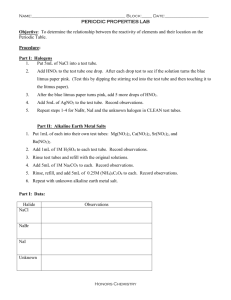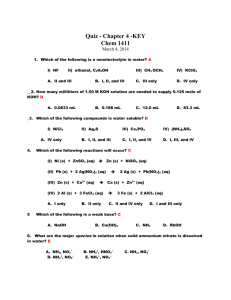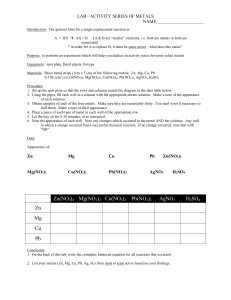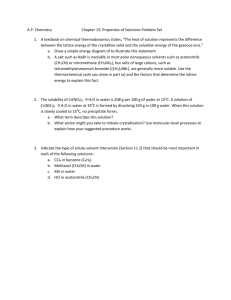Introduction - HCC Learning Web
advertisement
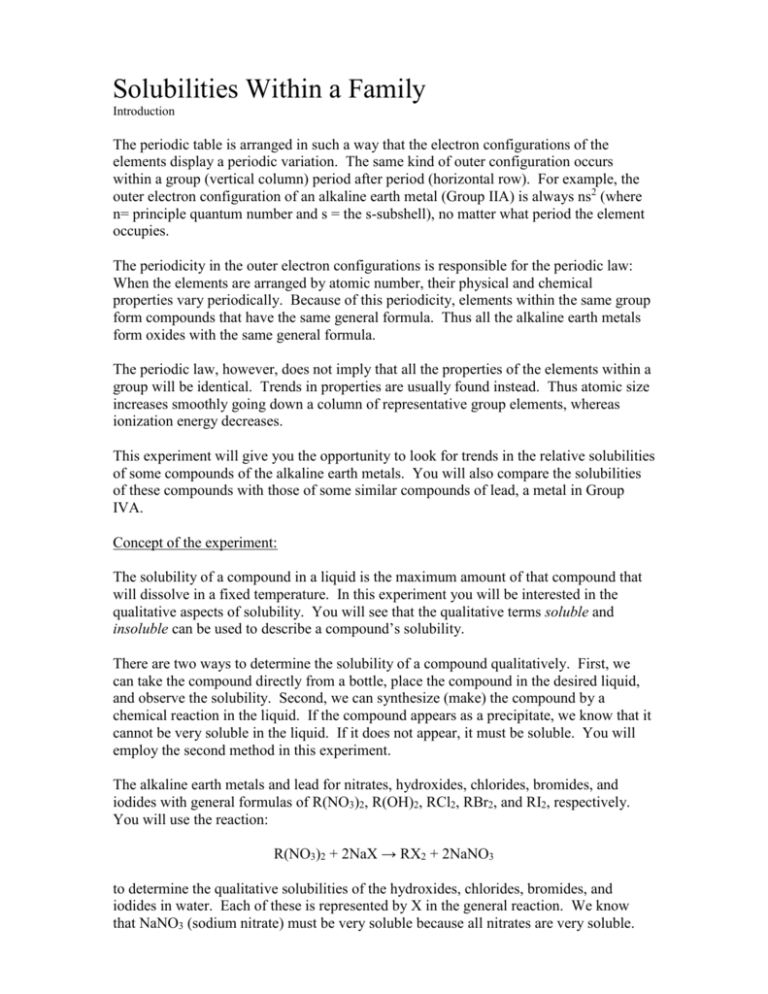
Solubilities Within a Family Introduction The periodic table is arranged in such a way that the electron configurations of the elements display a periodic variation. The same kind of outer configuration occurs within a group (vertical column) period after period (horizontal row). For example, the outer electron configuration of an alkaline earth metal (Group IIA) is always ns2 (where n= principle quantum number and s = the s-subshell), no matter what period the element occupies. The periodicity in the outer electron configurations is responsible for the periodic law: When the elements are arranged by atomic number, their physical and chemical properties vary periodically. Because of this periodicity, elements within the same group form compounds that have the same general formula. Thus all the alkaline earth metals form oxides with the same general formula. The periodic law, however, does not imply that all the properties of the elements within a group will be identical. Trends in properties are usually found instead. Thus atomic size increases smoothly going down a column of representative group elements, whereas ionization energy decreases. This experiment will give you the opportunity to look for trends in the relative solubilities of some compounds of the alkaline earth metals. You will also compare the solubilities of these compounds with those of some similar compounds of lead, a metal in Group IVA. Concept of the experiment: The solubility of a compound in a liquid is the maximum amount of that compound that will dissolve in a fixed temperature. In this experiment you will be interested in the qualitative aspects of solubility. You will see that the qualitative terms soluble and insoluble can be used to describe a compound’s solubility. There are two ways to determine the solubility of a compound qualitatively. First, we can take the compound directly from a bottle, place the compound in the desired liquid, and observe the solubility. Second, we can synthesize (make) the compound by a chemical reaction in the liquid. If the compound appears as a precipitate, we know that it cannot be very soluble in the liquid. If it does not appear, it must be soluble. You will employ the second method in this experiment. The alkaline earth metals and lead for nitrates, hydroxides, chlorides, bromides, and iodides with general formulas of R(NO3)2, R(OH)2, RCl2, RBr2, and RI2, respectively. You will use the reaction: R(NO3)2 + 2NaX → RX2 + 2NaNO3 to determine the qualitative solubilities of the hydroxides, chlorides, bromides, and iodides in water. Each of these is represented by X in the general reaction. We know that NaNO3 (sodium nitrate) must be very soluble because all nitrates are very soluble. Thus if a precipitate appears, it can only be RX2, and this must mean that this compound is not very soluble in water. The Alkaline earth metals and lead also form sulfates, carbonates, oxalates, and chromates with general formulas of RSO4, RCO3, RC2O4, and RCrO4, respectively. These compounds will be prepared by the reaction: R(NO3)2 + 2NaY → RY + 2NaNO3 Where Y represents sulfate, carbonate, oxalate, and chromate. The solubilities of the RY compounds will be determined in exactly the same way as those of the RX compounds. Because you will be examining only the qualitative aspects of the solubilities of thise compounds, you will not observe trends directly. Instead, you will need to infer their presence. The following example should make this process easier. Consider the solubilities of the chromates shown in the below table. Let us pretend for the moment that we do not know these solubilities. What would you find if you were to use a chemical reaction to produce 1.0 X 10-4 mol of each substance in 1000 mL of water? Note that only the solubility of BaCrO4 has been exceeded. As a result, all of the MgCrO4, CaCrO4, and SrCrO4 would remain in solution, and a precipitate of BaCrO4 would appear. This experiment would force us to admit the possibility that if a trend exists, the solubilities may decrease as the atomic number of the Group IIA metal increases. As the table below shows, this is correct. MgCrO4 9.9 Solubilities of Some Chromates (mol/1000 mL H2O) CaCrO4 SrCrO4 1.2 5.9 x 10-3 BaCrO4 1.1 x 10-5 This example is not intended to portray a general trend. In some instances, solubilities will increase as the atomic number of the Group IIA metal increases. Solubilities Within a Family Procedure **NOTE: Use instructions provide by the instructor – DO NOT USE INSTRUCTIONS IN CHEMLAB! To remove the instructions on the screen, and free-up more working area, perform the following operation: click on the OPTIONS tab; then click on LAB ONLY. The instructions “disappear” and all of the area is now lab space.** Test tube 1 2 3 4 5 A 0.1M Mg(NO3)2 0.1M Ca(NO3)2 0.1M Sr(NO3)2 0.1M Ba(NO3)2 0.1M Pb(NO3)2 B 0.1M NaOH 0.1M NaOH 0.1M NaOH 0.1M NaOH 0.1M NaOH Step 1: Obtain 5 test tubes. Step 2: Add 5 mL of the appropriate metal-nitrate to test tubes 1-5, as indicated above. Step 3: Add 5 mL of 0.1M NaOH to the first test tube. Observe and note precipitates in the observations. Based on the contents of the test tube after NaOH was added, write the chemical equation of what happened. (Use the Chemical Properties function [right click on the test tube to select this option] to find the substances present in the test tube). Step 4: Repeat Step 3 for remaining test tubes. Step 5: Repeat Steps 1 through 4 in turn with 0.1 M NaCl, 0.1 M NaBr, 0.1 M NaI, 0.1 M Na2SO4, 0.1 M Na2CO3, and 0.1 M Na2C2O4 instead of the solution of 0.1 M NaOH. Solubilities Within a Family Observations Name:__________ Sect:____________ Data In the table below, indicate (P) if a precipitate was formed. Indicate (S) if the ions remained soluble. Mg(NO3)2 Ca(NO3)2 Sr(NO3)2 NaOH NaCl NaBr NaI Na2SO4 Na2CO3 Na2C2O4 Ba(NO3)2 Pb(NO3)2 Indicate balanced chemical reactions, by completing the reactants, for each reaction that produced a precipitate. If no reaction occurred, write “NO – REACTION”. NaOH (aq) + Mg(NO3)2 (aq) → NaOH (aq) + Ca(NO3)2 (aq) → NaOH (aq) + Sr(NO3)2 (aq) → NaOH (aq) + Ba(NO3)2 (aq) → NaOH (aq) + Pb(NO3)2 (aq) → NaCl (aq) + Mg(NO3)2 (aq) → NaCl (aq) + Ca(NO3)2 (aq) → NaCl (aq) + Sr(NO3)2 (aq) → NaCl (aq) + Ba(NO3)2 (aq) → NaCl (aq) + Pb(NO3)2 (aq) → NaBr (aq) + Mg(NO3)2 (aq) → NaBr (aq) + Ca(NO3)2 (aq) → NaBr (aq) + Sr(NO3)2 (aq) → NaBr (aq) + Ba(NO3)2 (aq) → NaBr (aq) + Pb(NO3)2 (aq) → NaI (aq) + Mg(NO3)2 (aq) → NaI (aq) + Ca(NO3)2 (aq) → NaI (aq) + Sr(NO3)2 (aq) → NaI (aq) + Ba(NO3)2 (aq) → NaI (aq) + Pb(NO3)2 (aq) → Na2SO4 (aq) + Mg(NO3)2 (aq) → Na2SO4 (aq) + Ca(NO3)2 (aq) → Na2SO4 (aq) + Sr(NO3)2 (aq) → Na2SO4 (aq) + Ba(NO3)2 (aq) → Na2SO4 (aq) + Pb(NO3)2 (aq) → Na2CO3 (aq) + Mg(NO3)2 (aq) → Na2CO3 (aq) + Ca(NO3)2 (aq) → Na2CO3 (aq) + Sr(NO3)2 (aq) → Na2CO3 (aq) + Ba(NO3)2 (aq) → Na2CO3 (aq) + Pb(NO3)2 (aq) → Na2C2O4 (aq) + Mg(NO3)2 (aq) → Na2C2O4 (aq) + Ca(NO3)2 (aq) → Na2C2O4 (aq) + Sr(NO3)2 (aq) → Na2C2O4 (aq) + Ba(NO3)2 (aq) → Na2C2O4 (aq) + Pb(NO3)2 (aq) → Questions 1. What trends in the solubilities of the compounds of the alkaline earth metals can be inferred? 2. Compare the solubilities of the lead compounds with those of the alkaline earth metals. How are the solubilities similar, and how do they differ? 3. As you have seen, lead can form the same kinds of compounds as the alkaline earth metals. Nevertheless, the solubilities may differ markedly. Give a convincing reason. Discussion


